Cooler Master Storm Scout II Advanced Case Review: Falling Behind the Curve
by Dustin Sklavos on March 19, 2013 12:01 PM EST- Posted in
- Cases/Cooling/PSUs
- Cooler Master
- ATX
Noise and Thermal Testing
Part of the problem with going with a bog standard ATX cooling design is that you effectively hamstring your performance out of the gate. It's only through experimentation that a product can hit the high highs and the low lows, but Cooler Master may have played it too safe with the Storm Scout II Advanced. It goes without saying that it will produce adequate performance with our stock testbed, but when things get hairy in the overclocked and full fat beds, it's liable to have a much harder time competing.
Ambient temperature hovered around 22C for most of testing. Note that all competing test results on the chart are from our previous testbed; margin of error in load thermal results remains at around 1C, but idle thermals on the CPU are reported much more frequently on the new motherboard, and as a result, idle temperatures will appear lower.
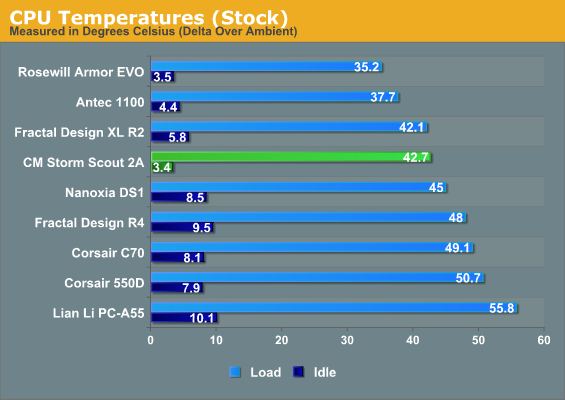
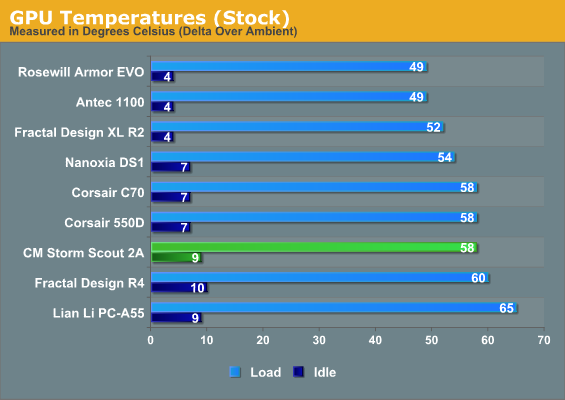
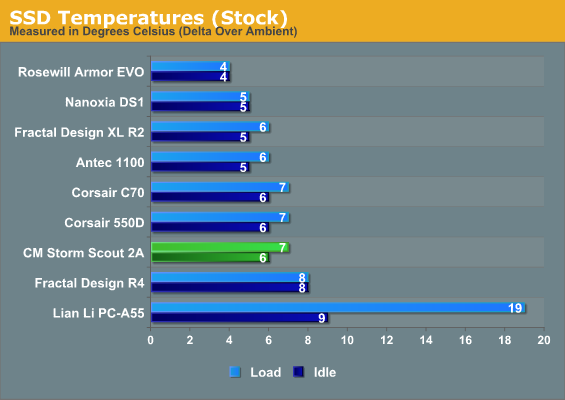
Even in our stock configuration, the Storm Scout II Advanced doesn't excite. CPU performance is competitive but not exceptional, while GPU performance is comparatively poor. This doesn't bode well for more taxing workloads.
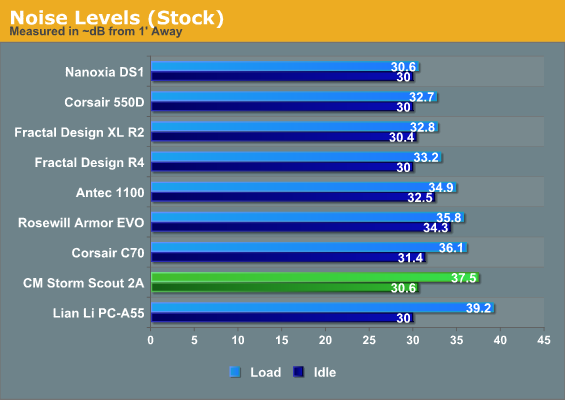
Unfortunately, the Storm Scout II Advanced has a hard time keeping the noise down, too. It's hard to pin the issue on a specific cause, but I suspect the conservative cooling design may be slightly exacerbated by mediocre fan choices. Despite the two 120mm intake fans, the GPU is clearly having a hard time staying cool and is responsible for a lot of the load noise as a result.
Things don't improve when we overclock the CPU and graphics card.
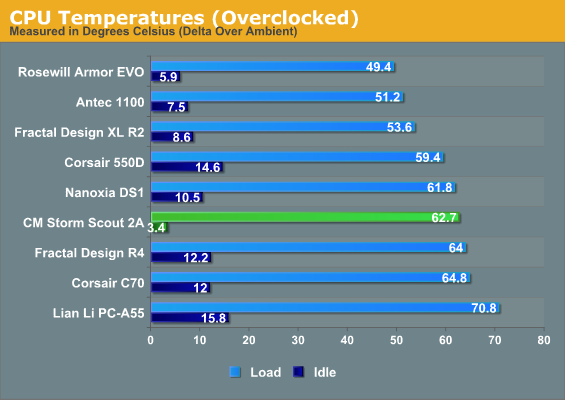
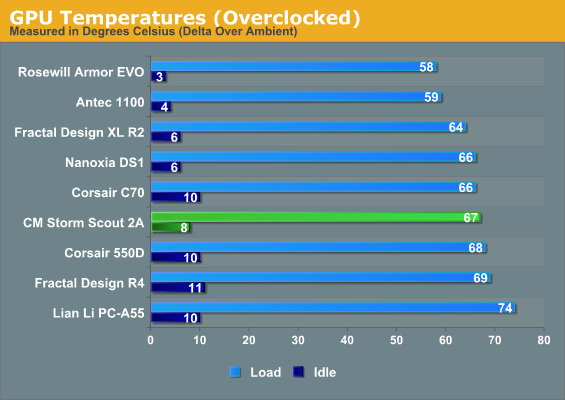
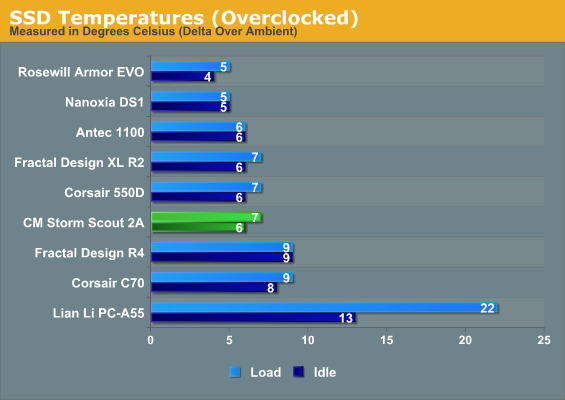
Thermal results and the Storm Scout II Advanced's comparative standing don't really change too much; the CPU thermals get a little less competitive, but the overclock on the graphics card starts to overwhelm some of the competition as well.
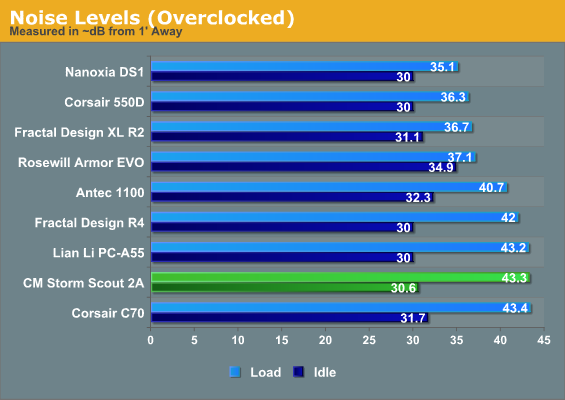
The mediocre thermals really aren't helped by aggravatingly high noise levels, either. This is not a case suitable for overclocking, at least not unless you're planning on adding additional intake fans to the side panel.
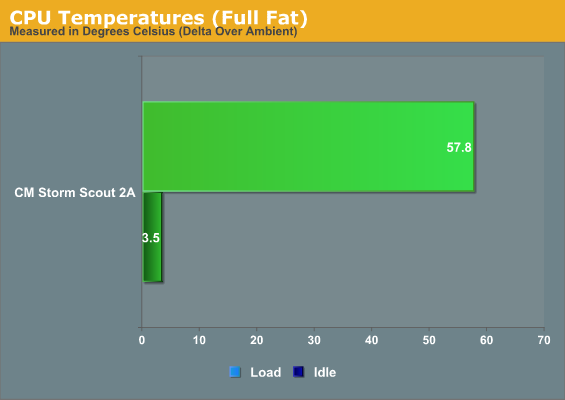


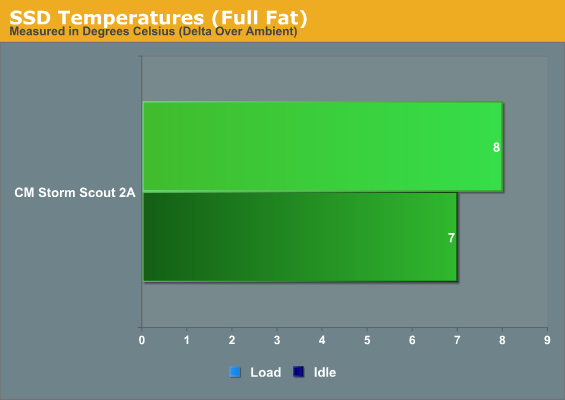
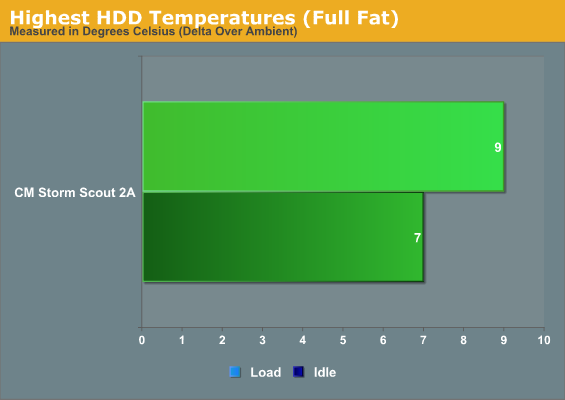
Without proper results to compare to, it may be difficult to get a feel for how the Storm Scout II Advanced is performing. Basically what's happening, though, is that the two GTX 580s have a target temperature where the fans will spin more and more aggressively to keep them there, and they're hitting that temperature: roughly 92-94C.
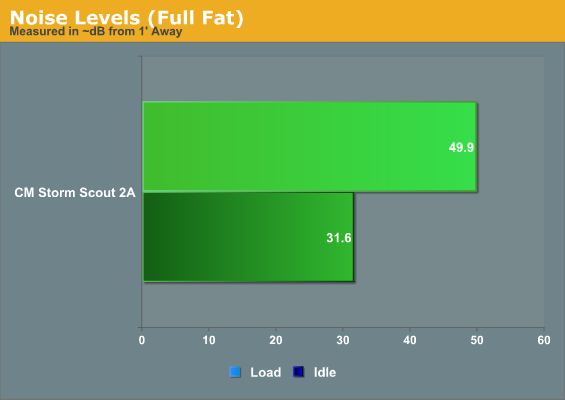
Load noise is awfully unpleasant, too: the Storm Scout II Advanced is nipping just under 50dB, which is frankly unacceptable.










16 Comments
View All Comments
MrCommunistGen - Tuesday, March 19, 2013 - link
On page 4 in the ATX Test Configuration table in the GTX 580 description you have: "(full fat testing only)" which is actually a little bit amusing but it should probably say: full fan testing based on context.MrCommunistGen - Tuesday, March 19, 2013 - link
well... I guess since you used that terminology again I guess it was intentional.JarredWalton - Tuesday, March 19, 2013 - link
It's a reference to types of milk or cream: you have the "light" options with reduced fat (easier on your body in theory), and then there's the "full fat" milk and cream where you get all the flavor along with all the fat. I suppose it's probably used outside of dairy stuff as well, but you get the point. :-)MrCommunistGen - Tuesday, March 19, 2013 - link
Yeah after I kept reading I realized it was meant to by synonymous with "heavy duty" or the like. The terminology just caught me off guard.pcfxer - Wednesday, March 20, 2013 - link
The power of a hyphen ;)>. Full-Fat Testing!Grok42 - Tuesday, March 19, 2013 - link
I really liked your comment about the bog standard ATX case layout design as "...been done". Couldn't have said it better. Why through yet another ATX case at us, give us something different.bogda - Wednesday, March 20, 2013 - link
Why is gallery at anandtech simplified to stupidity?You can go next by clicking anywhere on picture but you cannot go back by clicking on left side of image as it is usual. If you want to go back you have to click on "film strip" at the bottom. It is not intuitive and requires more time, especially if "film strip" moved to next page.
REALfreaky - Wednesday, March 20, 2013 - link
The best performer for the price (Antec GX700) is ugly as sin. One of the better looking cases (this CM Storm Scout) is a poor performer and overpriced.Why is it so hard to find both? The exterior looks of this CM Storm Scout and the internal configuration and price of the GX700 would impress to no end.
TGressus - Wednesday, March 20, 2013 - link
The case could be a a good performer. It has 5 fan mounts that the reviewer chose to leave unpopulated, instead relying on the manufacturer's bare minimum. It is up to the consumer to design and tune their own system, and it is true the less experienced in the community would benefit from more detailed guidance in this area.alsmith - Saturday, November 22, 2014 - link
Both as in poor performer and ugly? I bet there'd be a few suggestions ......